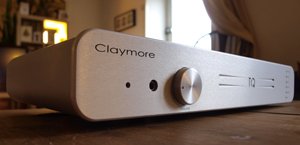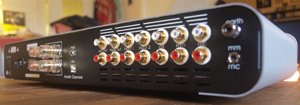Many of you will be forgiven for thinking that you’ve heard the Claymore name somewhere before and you’d be  absolutely right – Colin Wonfor, the Technical Director at Tellurium Q, was the person behind the somewhat legendary IncaTech Claymore amplifier from the 80s. So it was with a good deal of excitement that we awaited the arrival of the all new £3760 Claymore.
absolutely right – Colin Wonfor, the Technical Director at Tellurium Q, was the person behind the somewhat legendary IncaTech Claymore amplifier from the 80s. So it was with a good deal of excitement that we awaited the arrival of the all new £3760 Claymore.
It’s a stylish looking unit being quite slim on the rack and with just a motorised volume knob, a headphone jack and a series of LEDs to let you know what source is playing on the front – source selection is controlled from the elegant and weighty wand-style remote control.
So what functions do you actually get with the Claymore? Well it’s pretty well specified to say the least and this seems to be a route many companies are taking, realising that not everyone wants to have boxes and boxes littering up their front rooms. In just the one box you have a phonostage catering for Moving Magnet and Moving Coil cartridges (switchable on the rear), three line inputs, a mini-jack input for MP3 players plus a USB DAC input. There’s a pre-out, a tape loop and a pair of hefty binding posts for loudspeaker cables.
Speaking to Colin Wonfor it is clear he is passionate about the need for high quality power supplies in all his amplifiers and the Claymore is no exception with Colin saying that the amplifier has a “total of fourteen power supplies… Complex it may be but it gives superb noise and interference rejection.” Even the infra red detection circuit for the remote gets its own power supply that is only active when a button on the remote is pressed.
Into 8 Ohms you get a continuous 72 Watts a channel and into 4 Ohms 81 Watts. 
Firing up the Claymore is not just a case of pressing on and letting it do its thing. First you turn on the unit which defaults to mute, you wait a few moments until the unit is ready and then you can press mute and you’re ready to go. It takes a few goes to get your head around it but it becomes second nature after a few goes.
The first thing you notice once you do fire up the amp is that it seems to really energise the bass in the room. On Ben Frost’s “By the Throat” the bass is guttural with the Claymore and being a bit of a bass junkie this is right up my street – though the bass frequencies are not over domineering, just tight and powerful. The prepared pianos on the same album sound very “real” and there’s an overall sense of the soundscape enveloping you.
I’m used to listening with just 20 Watts of Class A from Tellurium Q’s Iridium amp but I have to say I really enjoyed having the extra power on tap, though I struggled to turn the volume knob much past 10 o’clock (and I do listen pretty loud) with the 95db Mummys. With the little Q Acoustics Concept 20s (possibly a more realistic partnering) there’s a real feeling that the Claymore has grabbed the speakers firmly and is taking control of them to get the best from them.
The Claymore isn’t as refined as the Iridium (I really wouldn’t expect it to be) but it has a real sledgehammer weight  to the way it portrays music. This is not to say that the Claymore can’t be subtle, but I’d liken it to how I’d imagine stepping out of a chauffeur driven Bentley and into a V8 muscle car must feel.
to the way it portrays music. This is not to say that the Claymore can’t be subtle, but I’d liken it to how I’d imagine stepping out of a chauffeur driven Bentley and into a V8 muscle car must feel.
Techno seemed the order of the day, so on with The Field and the brilliant “Cupid’s Head” album and again this amp really plumbs the depths with the bass kick underpinning and giving a real solid foundation to the overall sound. On “20 Seconds of Affection” the evolving soundscapes just build and build and whilst that bedrock of bass is still evident, other sounds and ‘instruments’ throughout the frequency range are easy to pick out of the mix and offer a coherent and balanced presentation.
I’ve said it before and I don’t mind saying it again, some bits of kit just have you reaching for certain genres and with the Claymore I found myself being drawn to bass heavy music as this seemed to play to the amp’s strengths.
However, on Rumours from Fleetwood Mac and the tune “Songbird” the amp shows that it is capable if subtlety too – not as ultimately refined as the Iridium as I mentioned, but it manages to give a pretty realistic portrayal of the recorded space with the vocal and piano sounding unforced and natural.
There’s one track I was dying to try with the Claymore and that was Hardfloor’s “Once Again and Back”. There’s a bass break at the start that is a must for anyone of the bass addicted persuasion. Here the bass doesn’t take over (I thought it would) and what you get is a nicely balanced rendition of the track.
Gil Scott-Heron’s “Pieces of a Man” was popped on next and you do get a really nice insight into the emotion in his voice. The vocal is slightly forward in the mix with the other instruments sitting behind and around the stereo image. Piano sounds as it should and the bass sounds realistic too. Perhaps on this tune is where I most noticed the difference between the Iridium and the Claymore – the Claymore doesn’t have that last smidgen of finesse, particularly at the top end, but it’s really not that far off at all. On “Sign of the Ages” from the same album there’s a feeling that you are listening to a live recording and there is a good degree of delicacy and deftness of touch from the amp. It’s hugely dynamic with it dealing with quieter passages very nicely, but having immediate power on hand to deal with louder passages or instruments in the mix as demonstrated on Ry Cooder’s “Paris Texas” soundtrack where there’s bags of detail and texture and also on “Night Train to You” by the Marcin Wasilewski Trio. 
Phonostage
The inbuilt phonostage gives a good solid performance with pinpoint imaging and a wide and especially deep soundstage. Instruments seem to have good space around them and I’d say that the Claymore’s phonostage at least equals my own Electrocompaniet stage.
Vocals on Chie Ayado’s “Don’t Let Me Down” from the album “Good Life” are natural sounding with a good insight into the recording and the piano too is natural sounding missing only the Iridium’s very top end effortlessness.
USB/DAC
This works very well indeed and I’m sure for folk who don’t want to go to the expense of shelling out loads on an external USB DAC it will be very popular. Did it match the VAD DAC? Well no it didn’t to be honest as it lacked that last nth of a degree of sophistication and polish, but then the VAD DAC costs more than this whole amp put together. Would I be happy to use it day to day– I’m pretty sure I would.
Headphone Amp
This is a useful addition to the Claymore and one I’m glad to see more and more manufacturers adding to their amps and pre’s as more and more music lovers demand a no-nonsense all in one solution.
I was able to use a couple of pairs of headphones and it performed perfectly well. Volume is adjusted by the main volume knob or the remote and when the headphone jack is fully inserted into the amp the speakers mute.
Similarly to the recently reviewed Van De Leur preamplifier the Claymore’s headphone amplifier should satisfy all but the most hardened headfi enthusiast. For those looking to listen occasionally to cans, or those forced to use headphones late at night, the inbuilt amp will be absolutely fine. Actually it’s pretty good with an even, balanced sound and with good drive.
Conclusion
At £3760 the Claymore isn’t a cheap integrated amp, however I do think it offers good value for money none the less. Add up the constituent parts and the quality of those parts and you can start to appreciate that to have all the extra boxes and wires would not only be more hassle, but would also be more expensive for the average music lover that just wants great sound with minimum bother.
I don’t really have anything negative to say about the Claymore overall, but if I was to be nitpicky the start up procedure is a bit of a pain at first until you get your head around it.
The phonostage is a bit of a boon I think given the growing resurgence of vinyl and I reckon that adding something like a Project Debut Carbon Turntable (£300), a pair of speakers like the Q Acoustics’ Concept 20s (£550 with stands) and using your computer running Foobar 2000 or similar you’d have a great sounding system for around £5K with cables and what not included. Add a reasonable pair of headphones and you have something that you can listen to when the family goes to bed leaving you to get your music fix in peace.
The amp will easily outgrow the relatively budget kit I’ve mentioned however and should allow you to upgrade ancillary kit a good deal further up the tree without feeling the need to change your amp for anything more expensive. 
Author – Stuart Smith






































































































































































































You must be logged in to leave a reply.